Do you want to fish at a place where every fish is a monster, every pool is full of potential, and every hookup produces a rod bending fight, complete with four foot high headshaking, splashing leaps followed by desperate runs intended to snap your tippet? If so, book a trip to the Rose River Farm – a picture perfect rural farm snugged up against the eastern edge of the Blue Ridge Mountains that sits on a mile of the Rose River. The $75 fee is the best money I’ve spent on anything all year.
I had been in contact with Douglas Dear, the owner, off and on for about six months. As a result of my interest and support of the Project Healing Waters Program sponsored by the Farm, Doug had been bugging me to come down and experience the fishing, I really didn’t know what to expect so kept waiting for a warm day. Now I know I should have gone on ANY day.
On a bright Thursday morning in early May, I charged out of Northern Virginia with the truck pointed towards Syria, VA. The drive from DC was not bad; it only took about 1.75 hours. When you pull into the Farm, hang a left and then stop at the Gazebo about a 100 yards down from the entrance.
I got out and walked over to the river to see what lay in store. The sun was just starting to come up and the light was flooding onto the top of the water; cutting right through to the rocky bed below. It revealed a checkerboard of massive trout spread out – as if in formation – lined up left to right, two to 3 feet apart for the entire length of the pool. I watched in amazement for a few minutes as the rainbows flashed left and right as they chomped on the nymphs that were floating by. I did not have to be convinced any further. This was the REAL DEAL. I moved quickly back to the truck, geared up, and hopped into the water to begin what I will remember as one of the best days of fishing that I have experienced.
I was actually here to fish with Jim, who had not arrived yet. Given that, I didn’t want to stray too far from the gazebo, so I limited my attention to the two pools that stretched in front of it. While I didn’t have any luck with the checkerboard of fish, that turned as I moved downstream about 25 yards. The water changes character a little bit from the pool to a broad run energized by a swift current. It only took a few casts, and I hooked up with my first beast of the day.
Jim pulled up just as I was getting as fish off. I wandered up to give him the good news that this was in a be a productive trip. While Jim and I were talking, the other two anglers who had permission to fish on this water on this day pulled up. We exchanged pleasantries, had a good chat about the farm environment and what was or was not working based on my limited experience over the last 45 minutes.
The Rose River Farm limits the pressure to four rods a day. That gives everyone plenty of room and you never feel crowded. Jim and I decided to start at the very bottom of the property and work upstream while the other two guys would start at the gazebo. Jim and I followed the wide, mower-cut path which paralleled the river to the end of the property.
Doug has made extensive improvements to the river. While it runs fairly flat and shallow elsewhere in the valley, he created small pools to hold the fish which are separated by 15 to 30 yard riffles to ensure plenty of aeration. In addition, all the banks are improved with rock walls where appropriate. It was pristine, yet still challenging as there are some trees that make casting sporty.
The end of the property is marked by a final deep, long pool that stretches approximately 20 yards. Jim started on it as I skipped upstream to hit the riffle rushing out of the the next pool upstream. While I had caught my first fish of the day on a midge, I decided to switch to a larger nymph and chose a size 14 caddis dragging a size 16 pheasant tail. I worked this new combo without immediate success until a light rain started. I moved off the stream to put on my wet weather jacket and re-rig with a different set of nymphs.
At this point, Doug rolled up in an ATV and we had a good chat about the upcoming to fly tournament that they were holding to generate donations for Project Healing Waters. Doug threw an experienced glance at my pitiful “new guy” box of nymphs and gave me some advice on what to use and when to switch to dry flies. One of the things that Doug said that was very interesting was that he had fished extensively in Montana. When there, he was frustrated by driving for an hour on dirt roads to the “great” streams only to hit the trailhead and encounter five or six other cars. His opinion was the fishing he provided on the Rose River was better. My only recent experience with western trout was in the Mount Shasta area of California with great luck on both the Pit and Upper Sacramento Rivers . Glad I did not go to Montana – it’s a lot cheaper to spend 75 bucks to enjoy this spot!
Doug said goodbye and went back upstream to tend to the details of the Two Fly Tournament that would occur that weekend and left me to my own devices, mulling his advice. Not being stupid, I decided to follow it and immediately began to pick up massive rainbows with the normal size being about 16 inches with the largest probably hitting 18 inches in length.

Jim with a typical “beast”
Each of these fish exhibited wild trout characteristics. Doug told me that they get their fish from a hatchery out near Monterey, Virginia. This particular hatchery purposely raises stocked trout as close to the wild as it can. The trout live in clay raceways and are fed a mix of bugs and crayfish so they have no trouble adapting to real water. Given the fact that they are raised in fast water, they have the strength of a wild trout and, after looking at the shoulders on these monsters, I had to agree.
And so the day went, Jim and I worked slowly upstream fishing from pool to pool. I had great luck on nymphs as well as orange crayfish patterns bounced along the bottom. We crossed over in the middle with the other two guys and exchanged intelligence. They had good luck on nymphs and were switching to dry flies to inject some variation into the day. Me? I stuck with nymphs and actually pulled in a smallie at the upper end of the farm.
By this time, it was about 4:30 in the afternoon. Jim had a long drive in front of him and headed out, but I decided to stay for as late as I could in the hopes of seeing the fish turn onto dry flies as evening cooled the valley. With a quick goodbye to Jim, and I walked the mile back to the southern end of the property to work the pool where Jim started his day. After wading cautiously into the water, I looked upstream and saw tentative swirls of trout as they began to take off the top. These became more and more aggressive as time went on to include full body jumps out of the water! In fact, on one of my false casts, I was shocked to see a trout launch out of the water in a desperate attempt to grab my fly! Had I died and gone to heaven? Nope. I was at the Rose River Farm – a place almost as good.
With the sun low on the horizon, these trout were anxious to take anything off the top. Every strike included a massive, full-bodied swirl that gave you a quick glimpse of the big pig making a desperate run against your dry. As usual, I pulled my fly away too early on many of these. “Calm down”, I told myself, “Calm down”. I began to apply the lesson from Lefty’s DVD and repeated the mantra of saying “God save the Queen” before I raised my rod to set the hook. With that, I began to have more hookups. Game on! These are essentially wild fish, and they don’t like being hooked. The trout would immediately lurch into a desperate dance, sometimes launching itself three to four feet out of the water while shaking its head viciously in an attempt to free the fly. Upon landing, they would race up and down the pool swirling, churning and splashing the water (here’s a brief video I took of one trout). Since I was using a 6X tippet, I took my time and gently worked them to hand. This action lasted for a least another hour!
Finally, I had to face reality. I looked at my watch, it was 6:30, I knew I had a two hour drive to get home. So reluctantly, I had to bid farewell to the Rose River Farm.
Rose River Farm Trout Fishing Bottom line: This place is absolutely fantastic. It’s well worth the $75 fee (2008) to enjoy an unpressured day on a great, improved trout stream. Given I spent 10 hours on site, the cost per hour is a bargain in anyone’s budget.
Doug indicated that this year they have been fully booked with four anglers a day since their opening in the spring. I would have thought the fish would have been well schooled and tough to catch by May. Maybe they are as dumb as they are wild, but in any case, they are full of fight.
The Rose River Farm will shut down for fishing fairly soon. They close when the water warms up to protect the fish from the stress of the catch and release regulation they impose on the property. So if you have some time, I strongly recommend you spend it here and get the same level of enjoyment out of this fantastic stretch of water as I did.
Getting There: Book a trip at www.roseriverfarm.com and they will send you the directions on how to get to the farm.
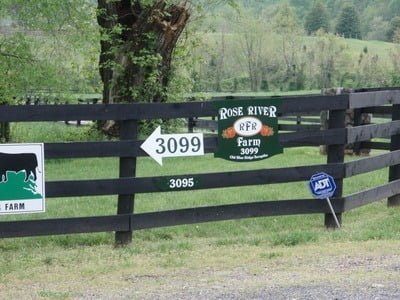
Hang a left after you pull off the road
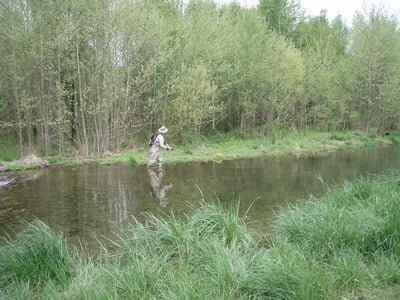
The first pool at the southern end of the property
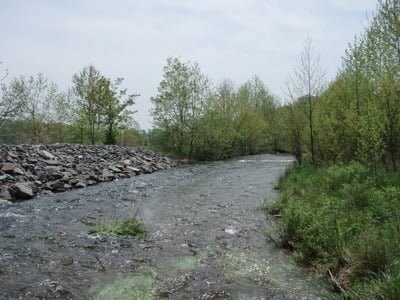
Typical riffle – note the improvements to the bank
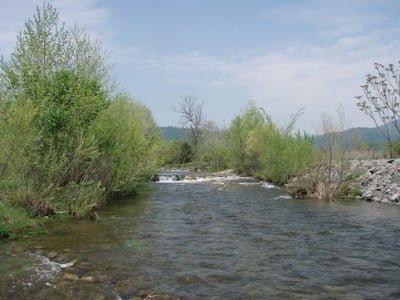
Riffles lead to nice, improved pools.
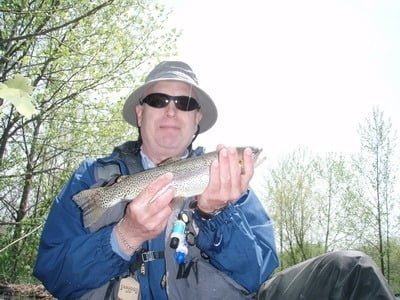
Why isn’t this guy smiling? I was stunned to get a fish like this!
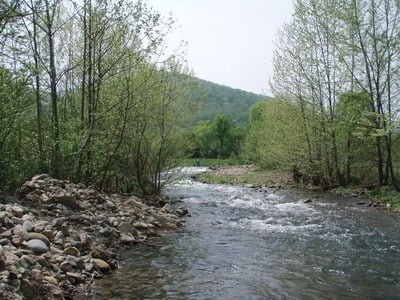
One of the longer riffles
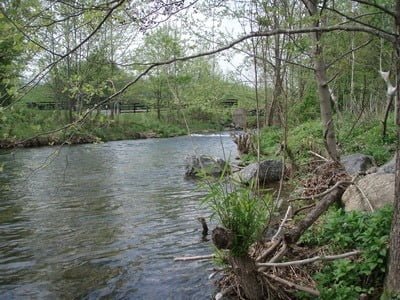
One of the few trees carefully planted to get your flies
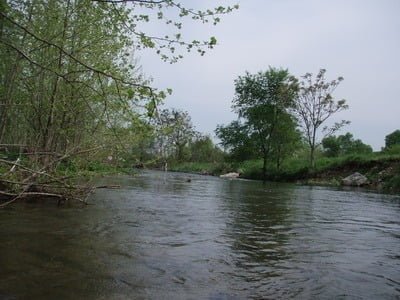
Broad pools, typically 5 feet deep (Doug said the water was high on the day I was there)
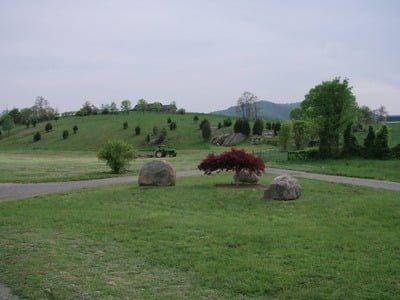
This is a real farm
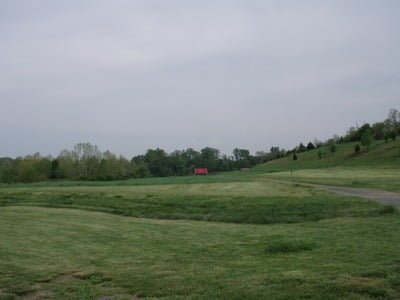
Scenic rolling hills
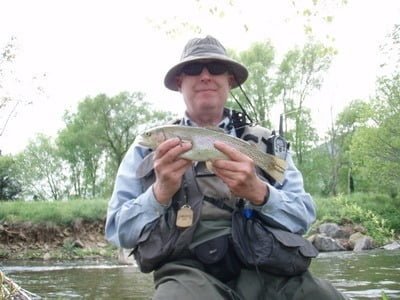
One of many nice fish!
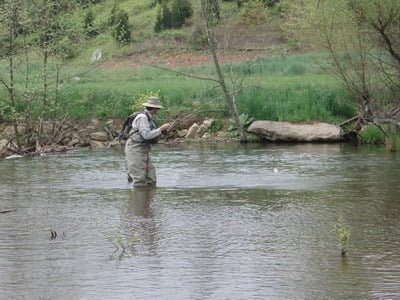
Jim hooking a good one
Unless stated otherwise, this article was authored by Steve Moore


